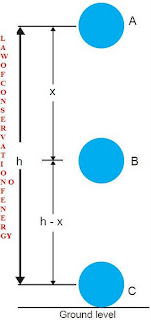CBSE PHYSICS: LAW OF CONSERVATION OF ENERGY(9th physics):
LAW OF CONSERVATION OF ENERGY
Energy can neither be created nor destroyed, but it
is transformed from one form to another. Alternatively,
whenever energy gets transformed, the total energy
remains unchanged.
Proof – Freely falling body
It may be shown that in the absence of external frictional force the total mechanical energy of a body remains constant.
Let a body of mass m falls from a point A, which is at a height h from the ground as shown in fig.
Potential energy Ep = mgh
Total energy E = Ep + Ek = mgh + 0= mgh
Potential energy Ep = mg (h – x)
Total energy E = Ep + Ek = mg (h-x) + mgx = mgh – mgx + mgx= mgh
If the body reaches the position C.
At C,
Potential energy Ep = 0
Velocity of the body C is
v2 = u2 + 2as
u = 0, a = g, s = h
applying v2 = 0 + 2gh = 2gh
kinetic energy Ek =1/2 mv2=1/2 m x 2gh= mgh
Total energy at C
E = Ep + Ek
E = 0 + mgh
E = mgh
Thus we have seen that sum of potential and kinetic energy of freely falling body at all points remains same. Under the force of gravity, the mechanical energy of a body remains constant.
RATE OF DOING WORK (OR) POWER
Power is defined as the rate of doing work or work done per unit time.Watt hour = power in watt x time in hour.
Energy can neither be created nor destroyed, but it
is transformed from one form to another. Alternatively,
whenever energy gets transformed, the total energy
remains unchanged.
Proof – Freely falling body
It may be shown that in the absence of external frictional force the total mechanical energy of a body remains constant.
Let a body of mass m falls from a point A, which is at a height h from the ground as shown in fig.
At A,
Kinetic energy kE = 0Potential energy Ep = mgh
Total energy E = Ep + Ek = mgh + 0= mgh
During the fall, the body is at a position B. The body has moved a distance x from A.
At B,
velocity v2 = u2 + 2as
applying, v2 = 0 + 2ax = 2ax
Kinetic energy Ek = 1/2 mv2 = 1/2 m x 2gx = mgxPotential energy Ep = mg (h – x)
Total energy E = Ep + Ek = mg (h-x) + mgx = mgh – mgx + mgx= mgh
If the body reaches the position C.
At C,
Potential energy Ep = 0
Velocity of the body C is
v2 = u2 + 2as
u = 0, a = g, s = h
applying v2 = 0 + 2gh = 2gh
kinetic energy Ek =1/2 mv2=1/2 m x 2gh= mgh
Total energy at C
E = Ep + Ek
E = 0 + mgh
E = mgh
Thus we have seen that sum of potential and kinetic energy of freely falling body at all points remains same. Under the force of gravity, the mechanical energy of a body remains constant.
RATE OF DOING WORK (OR) POWER
Power is defined as the rate of doing work or work done per unit time.
Power =work done/time taken
P = w/t
UNIT OF POWER
The unit of power is J/S known as watt, its symbol is W.
1 watt =1 joule/1 second
1 W = 1 J/ S
Commercial unit of energy is kilo watt hour
We pay electricity bill in terms of unit or kWh. It is a commercial unit of electric energy consumed by the user.
Example : How much energy will be used when a hundred watt bulb is used for 10 hour?
Energy = 100 watt x 10 hour = 1000 w h = 1kw h
I kwh is known as 1 unit.
One kilowatt hour means thousand watt of power is consumed in one hour.
1 kWh = 1 kW x 1 h
= 1000 W x 60 x 60 s
= 1000 Js-1 x 3600 s
= 3.6 x 106 J
1 unit = 1 kilowatt hour = 3.6x106 J


Comments
Post a Comment